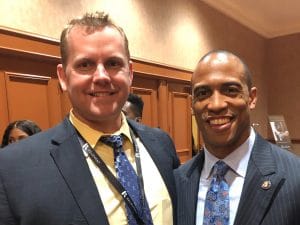Michael Harris is the Managing Director of CREModels, bringing over 25 years of real estate and technology experience and a lifetime of entrepreneurship to the team. Mr. Harris has held numerous roles within CREModels including Vice President of Emerging Technologies and Director of Marketing. In his current capacity as Managing Director, Mike oversees the marketing and general operations of the firm. Additionally, he is in charge of both client-facing and internal technology solutions while spearheading the CREModels Ventures and CREModels Labs divisions.
He successfully started and sold a Network Consulting company in the early 1990’s which handled both systems rollouts and training across the country. In the real estate world, Mr. Harris is known as an expert in distressed debt and REO transactions. He helped form the Special Assets Services division of a large commercial real estate brokerage firm and later served as Director of the Loan Sales division.
Mr. Harris also launched a Private Equity fund which acquires distressed commercial real estate assets in secondary markets of the US. To date they have over $25,000,000 in equity capital deployed. Mr. Harris has been involved in over $1 billion in transactions as a private investor, syndicator, broker, and lender.
Mike received his undergraduate degree in Mechanical Engineering from the University of South Florida, his MBA from the University of Florida and is a proud member of Mensa. Mr Harris has also attended the Real Estate Executive Seminar at Harvard Business School.
Mr. Harris also drives the CREModels Cares initiative and serves on the Board of Trustees for the Children’s Museum Great Explorations in St. Petersburg Florida. He also takes on an active role on the Marketing, Technology, and Fundraising committees at Great Explorations.



Content Featuring Mike Harris:
Consensus is growing in the shopping center industry about two key realities of the omni-channel age: The first is that sales per square foot no longer measures the full value of all stores and malls; the second is that retailers and landlords have made scant progress toward replacing it.
Read MoreReal estate developers and investors compete for attention with other professionals in the business, but often their financial models become an obstacle to their efforts.
Read MoreFor commercial and multifamily real estate developers, alignment and communication are the keys to raising capital amid an onslaught of investor demand, advises Mike Harris of CREModels.
Read MoreDespite the recent roller coaster ride on Wall Street, the latest round of Commercial Real Estate industry surveys points to continued optimism ahead for commercial real estate over the next 12 months.
Read MoreOne of the main focuses of the recently released Opportunity Zone guidance was on Qualified Opportunity Zone Businesses (QOZB). Michael Harris with CREModels indicated that the new guidance is hugely important for O-zone business which, in turn, will impact real estate development. Connect Media recently asked him a few questions about guidance clarifications, and how they impact both business and real estate in Opportunity Zones.
Read MoreAnnotated full-text of the primary portion of the Investing in Qualified Opportunity Zones Guidance from April 2019. Find out what IRS and Treasury have just released regarding the second tranche of guidance around Qualified Opportunity Zones.
Read MoreQualified Opportunity Zone guidance from Treasury and the IRS are a positive step in answering questions that will help to get capital off the sidelines.
Read MoreAnnotated full-text of the primary portion of the Investing in Qualified Opportunity Zones Guidance from April 2019. Find out what IRS and Treasury have just released regarding the second tranche of guidance around Qualified Opportunity Zones.
Read MoreRead our Real Estate Research Roundup of reports released at the end of 2018 and during Q1 2019 covering the outlook for 2019’s real estate market.
Read MoreIRR’s annual Viewpoint publication is perennial required reading, produced by one of the largest appraisal firms in the United States.
Read More









